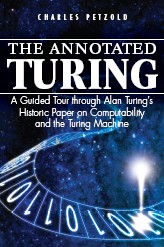Reading Hodges’ “One to Nine”
June 9, 2008
Roscoe, N.Y.
Anyone writing a book that has anything to do with Alan Turing (such as my book The Annotated Turing) benefits from having at the outset a valuable and ultimately indispensable resource: Andrew Hodges' extraordinary biography Alan Turing: The Enigma published in Great Britain and the United States in 1983. This biography is a model of its kind: very well researched, beautifully written, accurately informative about the mathematics, and quite moving.
My book The Annotated Turing is certainly not another biography of Turing, but rather an extended discussion of his 1936 paper that introduced the concepts of computability and the Turing Machine. However, in Chapters 4 through 11, I attempt to interweave biographical information about Turing with my presentation and discussion of the first 22 pages of Turing's paper. (It was one of the very fun challenges of writing these chapters to make chronological connections between Turing's post-1936 life and various sections of the paper without overstrained seques.) The number of footnotes in The Annotated Turing that reference Alan Turing: The Enigma is just one indication how much I relied upon Hodges' biography.
Andrew Hodges is an English mathematician whose "interest in Alan Turing developed partly through mathematics and partly through his participation in the 'gay liberation' movement" (to quote the biography in the original Simon and Schuster edition). Hodges also runs a website devoted to Turing. His mathematical work has involved working with Roger Penrose and Penrose's theory of twistors.
Andrew Hodges has recently written a new book entitled One to Nine: The Inner Life of Numbers published last year in Great Britain by W. W. Norton, and recently in the United States. The book's overall structure is simple: It has nine chapters, each of which is devoted to one of the first nine natural numbers. (Zero gets involved in the first and last chapters.) This might sound like a dreary over-determined exercise, but Hodges makes it a completely entertaining and even rollicking ride.
To Hodges, certain numbers seem engrained in the fabric of the universe, and reveal themselves in the structure of electromagnetism, spacetime, relativity, quarks, and quantum mechanics. At times there seems as much physics in this book as mathematics. (The Penrose influence?) Alan Turing shows up frequently, of course, and takes center stage in Chapter 8, which focuses on digital computing, but many other mathematicians, physicists, and ideas make appearances as well. This book darts among numerous topics with eager enthusiasm, and manages to be interactive as well, with little challenging number puzzles punctuating the text.
One to Nine is also interactive in the sense that I often found myself arguing with the author. I was very surprised to see Hodges acknowledge the univesality of 10 as a number base (or partial number base in the case of the ancient Babylonians) but question where it comes from:
-
The universality of ten is not fully explained by the form of the human hands. It would surely have been just as natural to use the eight fingers, not including thumbs. Eight-based counting would have been better suited to the repeated splitting of differences which is so natural for sharing and trading, as indeed for music. (p. 15)
I'm not sure Hodges really believes this himself — to me the cultural dominance of 10 is older and deeper than any explanation other than the digits at the end of our arms — but he waits for the last page of Chapter 9 (p. 320) to reveal why he believes 10 to have an additional existence independently of our fingers.
This is very much a book of the moment: Hodges uses the logic puzzle Sudoku as a motif of sorts, with its use of the digits 1 to 9 in their manifestation as unique symbols unburdened by culture or the physical world. There is also much pop culture in One to Nine. I counted three references to Desperate Housewives, and a great deal of music. (Hodges is also a composer.) Bach and Mahler show up, but also the Pet Shop Boys, who get so many mentions that they merit an entry in the index.
Hodges is also reeling from the continuing horrors of the Bush/Blair years, and a quiet rage about global warming and the Iraq War seems to simmer behind the pages. One of Hodges' examples involves statistics of the number of Iraqis killed as a result of the war (211-212), and a combinatorics example offers sardonic advice for interrogators of the "American-led coalition" (180). Yet with a brief shudder, Hodges is able to move on to yet another connecting topic. This book is nothing if not freewheeling!
At the very end Hodges presents a Sudoku puzzle containing 26 initial squares marked A through Z, each of which is a one-digit solution to a series of 26 additional little number puzzles. ("C: Find the penultimate digit of the trillionth power of 2.") Information about the book and solutions to the puzzles appears on Hodges' website Cool Math.
Throughout One to Nine, Hodges also compares and contrasts his text with Constance Reid's first book From Zero to Infinity: What Makes Numbers Interesting published in 1955 and based on a similar premise. And there we have another connection between this book and mine: Constance Reid (who turned 90 years old in January) shows up in the The Annotated Turing in two chapters. She is the author of the only major biography of David Hilbert in English, which I used a lot in Chapter 3, and she is the older sister of the late mathematician Julia Robinson, who is featured in my last chapter on the solving of Hilbert's Tenth Problem.

|
Now Available! | ||
| Wiley | Amazon US | Barnes & Noble | |
| Amazon Canada | Amazon UK | Amazon Deutschland | |
| Amazon France | Amazon Japan | Blackwell | |